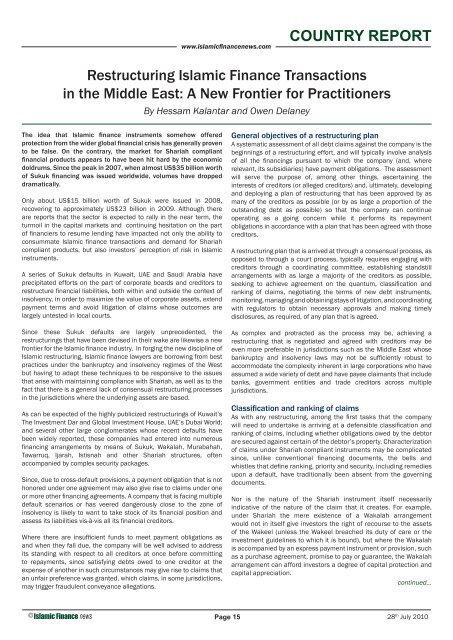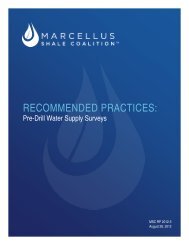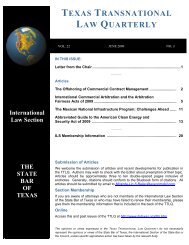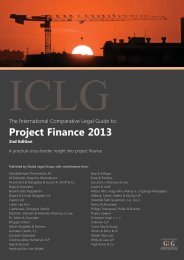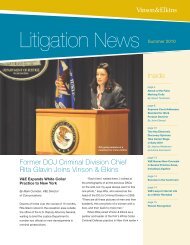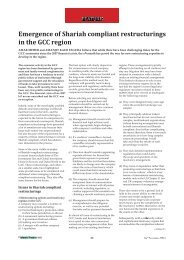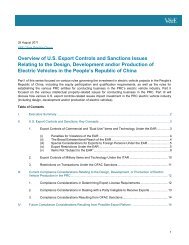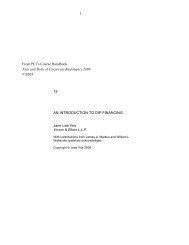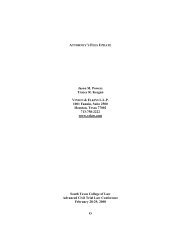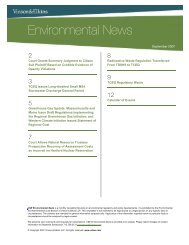Restructuring Islamic Finance Transactions in the Middle East: A ...
Restructuring Islamic Finance Transactions in the Middle East: A ...
Restructuring Islamic Finance Transactions in the Middle East: A ...
You also want an ePaper? Increase the reach of your titles
YUMPU automatically turns print PDFs into web optimized ePapers that Google loves.
www.islamicf<strong>in</strong>ancenews.com<br />
COUNTRY REPORT<br />
<strong>Restructur<strong>in</strong>g</strong> <strong>Islamic</strong> <strong>F<strong>in</strong>ance</strong> <strong>Transactions</strong><br />
<strong>in</strong> <strong>the</strong> <strong>Middle</strong> <strong>East</strong>: A New Frontier for Practitioners<br />
By Hessam Kalantar and Owen Delaney<br />
The idea that <strong>Islamic</strong> f<strong>in</strong>ance <strong>in</strong>struments somehow offered<br />
protection from <strong>the</strong> wider global f<strong>in</strong>ancial crisis has generally proven<br />
to be false. On <strong>the</strong> contrary, <strong>the</strong> market for Shariah compliant<br />
f<strong>in</strong>ancial products appears to have been hit hard by <strong>the</strong> economic<br />
doldrums. S<strong>in</strong>ce <strong>the</strong> peak <strong>in</strong> 2007, when almost US$35 billion worth<br />
of Sukuk f<strong>in</strong>anc<strong>in</strong>g was issued worldwide, volumes have dropped<br />
dramatically.<br />
Only about US$15 billion worth of Sukuk were issued <strong>in</strong> 2008,<br />
recover<strong>in</strong>g to approximately US$23 billion <strong>in</strong> 2009. Although <strong>the</strong>re<br />
are reports that <strong>the</strong> sector is expected to rally <strong>in</strong> <strong>the</strong> near term, <strong>the</strong><br />
turmoil <strong>in</strong> <strong>the</strong> capital markets and cont<strong>in</strong>u<strong>in</strong>g hesitation on <strong>the</strong> part<br />
of fi nanciers to resume lend<strong>in</strong>g have impacted not only <strong>the</strong> ability to<br />
consummate <strong>Islamic</strong> fi nance transactions and demand for Shariah<br />
compliant products, but also <strong>in</strong>vestors’ perception of risk <strong>in</strong> <strong>Islamic</strong><br />
<strong>in</strong>struments.<br />
A series of Sukuk defaults <strong>in</strong> Kuwait, UAE and Saudi Arabia have<br />
precipitated efforts on <strong>the</strong> part of corporate boards and creditors to<br />
restructure fi nancial liabilities, both with<strong>in</strong> and outside <strong>the</strong> context of<br />
<strong>in</strong>solvency, <strong>in</strong> order to maximize <strong>the</strong> value of corporate assets, extend<br />
payment terms and avoid litigation of claims whose outcomes are<br />
largely untested <strong>in</strong> local courts.<br />
S<strong>in</strong>ce <strong>the</strong>se Sukuk defaults are largely unprecedented, <strong>the</strong><br />
restructur<strong>in</strong>gs that have been devised <strong>in</strong> <strong>the</strong>ir wake are likewise a new<br />
frontier for <strong>the</strong> <strong>Islamic</strong> fi nance <strong>in</strong>dustry. In forg<strong>in</strong>g <strong>the</strong> new discipl<strong>in</strong>e of<br />
<strong>Islamic</strong> restructur<strong>in</strong>g, <strong>Islamic</strong> fi nance lawyers are borrow<strong>in</strong>g from best<br />
practices under <strong>the</strong> bankruptcy and <strong>in</strong>solvency regimes of <strong>the</strong> West<br />
but hav<strong>in</strong>g to adapt <strong>the</strong>se techniques to be responsive to <strong>the</strong> issues<br />
that arise with ma<strong>in</strong>ta<strong>in</strong><strong>in</strong>g compliance with Shariah, as well as to <strong>the</strong><br />
fact that <strong>the</strong>re is a general lack of consensual restructur<strong>in</strong>g processes<br />
<strong>in</strong> <strong>the</strong> jurisdictions where <strong>the</strong> underly<strong>in</strong>g assets are based.<br />
As can be expected of <strong>the</strong> highly publicized restructur<strong>in</strong>gs of Kuwait’s<br />
The Investment Dar and Global Investment House, UAE’s Dubai World;<br />
and several o<strong>the</strong>r large conglomerates whose recent defaults have<br />
been widely reported, <strong>the</strong>se companies had entered <strong>in</strong>to numerous<br />
fi nanc<strong>in</strong>g arrangements by means of Sukuk, Wakalah, Murabahah,<br />
Tawarruq, Ijarah, Istisnah and o<strong>the</strong>r Shariah structures, often<br />
accompanied by complex security packages.<br />
S<strong>in</strong>ce, due to cross-default provisions, a payment obligation that is not<br />
honored under one agreement may also give rise to claims under one<br />
or more o<strong>the</strong>r fi nanc<strong>in</strong>g agreements. A company that is fac<strong>in</strong>g multiple<br />
default scenarios or has veered dangerously close to <strong>the</strong> zone of<br />
<strong>in</strong>solvency is likely to want to take stock of its fi nancial position and<br />
assess its liabilities vis-à-vis all its fi nancial creditors.<br />
Where <strong>the</strong>re are <strong>in</strong>suffi cient funds to meet payment obligations as<br />
and when <strong>the</strong>y fall due, <strong>the</strong> company will be well advised to address<br />
its stand<strong>in</strong>g with respect to all creditors at once before committ<strong>in</strong>g<br />
to repayments, s<strong>in</strong>ce satisfy<strong>in</strong>g debts owed to one creditor at <strong>the</strong><br />
expense of ano<strong>the</strong>r <strong>in</strong> such circumstances may give rise to claims that<br />
an unfair preference was granted, which claims, <strong>in</strong> some jurisdictions,<br />
may trigger fraudulent conveyance allegations.<br />
General objectives of a restructur<strong>in</strong>g plan<br />
A systematic assessment of all debt claims aga<strong>in</strong>st <strong>the</strong> company is <strong>the</strong><br />
beg<strong>in</strong>n<strong>in</strong>gs of a restructur<strong>in</strong>g effort, and will typically <strong>in</strong>volve analysis<br />
of all <strong>the</strong> fi nanc<strong>in</strong>gs pursuant to which <strong>the</strong> company (and, where<br />
relevant, its subsidiaries) have payment obligations. The assessment<br />
will serve <strong>the</strong> purpose of, among o<strong>the</strong>r th<strong>in</strong>gs, ascerta<strong>in</strong><strong>in</strong>g <strong>the</strong><br />
<strong>in</strong>terests of creditors (or alleged creditors) and, ultimately, develop<strong>in</strong>g<br />
and deploy<strong>in</strong>g a plan of restructur<strong>in</strong>g that has been approved by as<br />
many of <strong>the</strong> creditors as possible (or by as large a proportion of <strong>the</strong><br />
outstand<strong>in</strong>g debt as possible) so that <strong>the</strong> company can cont<strong>in</strong>ue<br />
operat<strong>in</strong>g as a go<strong>in</strong>g concern while it performs its repayment<br />
obligations <strong>in</strong> accordance with a plan that has been agreed with those<br />
creditors.<br />
A restructur<strong>in</strong>g plan that is arrived at through a consensual process, as<br />
opposed to through a court process, typically requires engag<strong>in</strong>g with<br />
creditors through a coord<strong>in</strong>at<strong>in</strong>g committee, establish<strong>in</strong>g standstill<br />
arrangements with as large a majority of <strong>the</strong> creditors as possible,<br />
seek<strong>in</strong>g to achieve agreement on <strong>the</strong> quantum, classifi cation and<br />
rank<strong>in</strong>g of claims, negotiat<strong>in</strong>g <strong>the</strong> terms of new debt <strong>in</strong>struments,<br />
monitor<strong>in</strong>g, manag<strong>in</strong>g and obta<strong>in</strong><strong>in</strong>g stays of litigation, and coord<strong>in</strong>at<strong>in</strong>g<br />
with regulators to obta<strong>in</strong> necessary approvals and mak<strong>in</strong>g timely<br />
disclosures, as required, of any plan that is agreed.<br />
As complex and protracted as <strong>the</strong> process may be, achiev<strong>in</strong>g a<br />
restructur<strong>in</strong>g that is negotiated and agreed with creditors may be<br />
even more preferable <strong>in</strong> jurisdictions such as <strong>the</strong> <strong>Middle</strong> <strong>East</strong> whose<br />
bankruptcy and <strong>in</strong>solvency laws may not be suffi ciently robust to<br />
accommodate <strong>the</strong> complexity <strong>in</strong>herent <strong>in</strong> large corporations who have<br />
assumed a wide variety of debt and have payee claimants that <strong>in</strong>clude<br />
banks, government entities and trade creditors across multiple<br />
jurisdictions.<br />
Classification and rank<strong>in</strong>g of claims<br />
As with any restructur<strong>in</strong>g, among <strong>the</strong> fi rst tasks that <strong>the</strong> company<br />
will need to undertake is arriv<strong>in</strong>g at a defensible classifi cation and<br />
rank<strong>in</strong>g of claims, <strong>in</strong>clud<strong>in</strong>g whe<strong>the</strong>r obligations owed by <strong>the</strong> debtor<br />
are secured aga<strong>in</strong>st certa<strong>in</strong> of <strong>the</strong> debtor’s property. Characterization<br />
of claims under Shariah compliant <strong>in</strong>struments may be complicated<br />
s<strong>in</strong>ce, unlike conventional fi nanc<strong>in</strong>g documents, <strong>the</strong> bells and<br />
whistles that defi ne rank<strong>in</strong>g, priority and security, <strong>in</strong>clud<strong>in</strong>g remedies<br />
upon a default, have traditionally been absent from <strong>the</strong> govern<strong>in</strong>g<br />
documents.<br />
Nor is <strong>the</strong> nature of <strong>the</strong> Shariah <strong>in</strong>strument itself necessarily<br />
<strong>in</strong>dicative of <strong>the</strong> nature of <strong>the</strong> claim that it creates. For example,<br />
under Shariah <strong>the</strong> mere existence of a Wakalah arrangement<br />
would not <strong>in</strong> itself give <strong>in</strong>vestors <strong>the</strong> right of recourse to <strong>the</strong> assets<br />
of <strong>the</strong> Wakeel (unless <strong>the</strong> Wakeel breached its duty of care or <strong>the</strong><br />
<strong>in</strong>vestment guidel<strong>in</strong>es to which it is bound), but where <strong>the</strong> Wakalah<br />
is accompanied by an express payment <strong>in</strong>strument or provision, such<br />
as a purchase agreement, promise to pay or guarantee, <strong>the</strong> Wakalah<br />
arrangement can afford <strong>in</strong>vestors a degree of capital protection and<br />
capital appreciation.<br />
cont<strong>in</strong>ued...<br />
© Page 15<br />
28 th July 2010
www.islamicf<strong>in</strong>ancenews.com<br />
COUNTRY REPORT<br />
<strong>Restructur<strong>in</strong>g</strong> <strong>Islamic</strong> <strong>F<strong>in</strong>ance</strong> <strong>Transactions</strong> <strong>in</strong> <strong>the</strong> <strong>Middle</strong> <strong>East</strong>:<br />
A New Frontier for Practitioners (cont<strong>in</strong>ued)<br />
Similarly, with Sukuk, <strong>the</strong> precise rank<strong>in</strong>g of a certifi cate holder among<br />
o<strong>the</strong>r creditors of <strong>the</strong> company will depend on <strong>in</strong>terpret<strong>in</strong>g <strong>the</strong> language<br />
<strong>in</strong> <strong>the</strong> terms and conditions of <strong>the</strong> certifi cates, <strong>the</strong> declaration of trust<br />
and, where applicable, <strong>the</strong> purchase undertak<strong>in</strong>g executed by <strong>the</strong><br />
obligor <strong>in</strong> favour of <strong>the</strong> trustee. In <strong>the</strong> absence of standardized loan<br />
provisions typical <strong>in</strong> conventional credit, security and <strong>in</strong>tercreditor<br />
agreements, <strong>the</strong> rights and remedies of creditors <strong>in</strong> an <strong>Islamic</strong> fi nance<br />
context can vary considerably.<br />
Sukuk structures have typically been underp<strong>in</strong>ned by real estate<br />
assets that generate returns for lenders through, for example, a sale<br />
and leaseback arrangement under which <strong>the</strong> lender buys <strong>the</strong> real<br />
estate assets and <strong>the</strong> borrower leases it from <strong>the</strong> lender. This concept<br />
of “asset back<strong>in</strong>g” has become <strong>in</strong>creas<strong>in</strong>gly controversial <strong>in</strong> light of<br />
<strong>the</strong> scrut<strong>in</strong>y <strong>the</strong>se structures have attracted follow<strong>in</strong>g recent Sukuk<br />
defaults.<br />
Certa<strong>in</strong>ly, where certifi cate holders’ claims need to be classifi ed and<br />
ranked <strong>in</strong> connection with a contemplated restructur<strong>in</strong>g, a dist<strong>in</strong>ction<br />
will need to be made between Sukuk that are truly asset backed and<br />
those that are not. In <strong>the</strong> case of <strong>the</strong> former, legal title underly<strong>in</strong>g <strong>the</strong><br />
assets will <strong>in</strong> most cases have been transferred by <strong>the</strong> obligor to a<br />
special purpose vehicle aga<strong>in</strong>st which <strong>in</strong>vestors <strong>in</strong> a default scenario<br />
could make a legitimate claim under <strong>the</strong> declaration of trust based on<br />
<strong>the</strong> issuer’s legal ownership <strong>in</strong>terest <strong>in</strong> that asset.<br />
In <strong>the</strong> case of <strong>the</strong> latter (which are beg<strong>in</strong>n<strong>in</strong>g to attract <strong>the</strong> name<br />
“asset-based”), however, <strong>the</strong>re is a real risk that <strong>the</strong>re was never an<br />
effective transfer of an ownership <strong>in</strong>terest <strong>in</strong> <strong>the</strong> underly<strong>in</strong>g asset, with<br />
<strong>the</strong> result that <strong>the</strong> <strong>in</strong>vestors have at best a benefi cial <strong>in</strong>terest <strong>the</strong>re<strong>in</strong><br />
(and <strong>in</strong> many cases noth<strong>in</strong>g more than recourse to <strong>the</strong> balance sheet<br />
of <strong>the</strong> obligor as opposed to recourse to <strong>the</strong> underly<strong>in</strong>g assets) and<br />
thus fare no better than o<strong>the</strong>r unsecured creditors. Indeed, it was<br />
recently reported that as little as 4% of <strong>the</strong> US$32 billion of Sukuk that<br />
Moody’s rated <strong>in</strong> 2009 affords <strong>in</strong>vestors direct recourse to <strong>the</strong> assets<br />
underp<strong>in</strong>n<strong>in</strong>g <strong>the</strong>ir <strong>in</strong>vestments.<br />
Also relevant to arriv<strong>in</strong>g at a classifi cation of secured versus unsecured<br />
claims is determ<strong>in</strong><strong>in</strong>g whe<strong>the</strong>r procedures relat<strong>in</strong>g to perfection of<br />
security have been duly undertaken. A creditor may have entered <strong>in</strong>to<br />
an agreement with <strong>the</strong> debtor grant<strong>in</strong>g <strong>the</strong> creditor security over a<br />
specifi c asset, only to discover all too late that <strong>the</strong> security <strong>in</strong>terest<br />
created under that agreement was not perfected <strong>in</strong> accordance with<br />
certa<strong>in</strong> jurisdictional requirements, such as hav<strong>in</strong>g possessory control<br />
over <strong>the</strong> asset, issu<strong>in</strong>g notice to certa<strong>in</strong> parties, or mak<strong>in</strong>g certa<strong>in</strong><br />
court fi l<strong>in</strong>gs.<br />
The uncerta<strong>in</strong>ties surround<strong>in</strong>g <strong>the</strong> extent to which one class of<br />
creditors may claim to have preference over ano<strong>the</strong>r class, or recourse<br />
to assets <strong>in</strong> priority to o<strong>the</strong>rs, serve of course to <strong>in</strong>crease <strong>the</strong> debtor’s<br />
leverage as it refi nes its restructur<strong>in</strong>g plan and negotiates its contents<br />
with its creditors. The ambiguities surround<strong>in</strong>g remedies upon default<br />
are likely to entice creditors to agree to a plan as opposed to seek<br />
enforcement of claims through <strong>the</strong> courts. Even if a restructur<strong>in</strong>g plan<br />
that is agreed with creditors acknowledges recourse by some or all<br />
such creditors to <strong>the</strong> debtor’s assets, <strong>the</strong> value of those assets may<br />
have dim<strong>in</strong>ished such that <strong>the</strong> restructured payment obligations can<br />
no longer be adequately collateralized.<br />
In such scenarios <strong>the</strong> restructur<strong>in</strong>g plan can provide for <strong>the</strong> <strong>in</strong>clusion<br />
of additional unencumbered assets to fully “asset-back” <strong>the</strong> new<br />
arrangement and <strong>in</strong>clude steps, for example, to effect a reorganization<br />
of <strong>the</strong> company’s subsidiaries and o<strong>the</strong>r assets so that such assets<br />
can be consolidated and transferred to special purpose vehicles<br />
(where permitted by foreign ownership laws) and pledged <strong>in</strong> favour of<br />
<strong>the</strong> creditors.<br />
Ano<strong>the</strong>r layer of complexity to characteriz<strong>in</strong>g and rank<strong>in</strong>g claims is<br />
that <strong>the</strong> <strong>in</strong>terpretation of <strong>the</strong> relevant Shariah fi nanc<strong>in</strong>g arrangement,<br />
<strong>in</strong>clud<strong>in</strong>g whe<strong>the</strong>r it allows recourse to certa<strong>in</strong> assets, will be impacted<br />
by <strong>the</strong> law that <strong>the</strong> parties have agreed should govern <strong>the</strong> arrangement,<br />
and <strong>the</strong> degree to which <strong>the</strong> application of those laws by <strong>the</strong> relevant<br />
courts would give precedence to Shariah.<br />
Approvals of Shariah boards, creditors and <strong>in</strong>vestors<br />
Any successful restructur<strong>in</strong>g of Shariah compliant <strong>in</strong>struments will<br />
require consultation with, and approval from, <strong>the</strong> relevant Shariah<br />
boards. The company’s Shariah board will need to approve numerous<br />
facets of <strong>the</strong> restructur<strong>in</strong>g plan, <strong>in</strong>clud<strong>in</strong>g, for example, <strong>the</strong> compliance<br />
of <strong>the</strong> various refi nanc<strong>in</strong>g mechanisms with <strong>the</strong> precepts of Shariah,<br />
particularly <strong>the</strong> amendments to Shariah compliant fi nanc<strong>in</strong>g<br />
arrangements and <strong>the</strong> implementation of <strong>the</strong> refi nanc<strong>in</strong>g. While some<br />
creditors may choose to rely on such approval, o<strong>the</strong>rs may require<br />
that <strong>the</strong> relevant refi nanc<strong>in</strong>g arrangements be approved by <strong>the</strong>ir own<br />
Shariah board.<br />
Upon a determ<strong>in</strong>ation by <strong>the</strong> respective boards that <strong>the</strong> arrangements<br />
are Shariah compliant, fatwas (or <strong>Islamic</strong> compliance certifi cates) <strong>in</strong><br />
relation to <strong>the</strong> arrangements will need to be obta<strong>in</strong>ed. Balanc<strong>in</strong>g <strong>the</strong><br />
<strong>in</strong>terests of multiple Shariah boards may be as time consum<strong>in</strong>g as<br />
balanc<strong>in</strong>g <strong>the</strong> compet<strong>in</strong>g <strong>in</strong>terests of creditors, and this should be<br />
taken <strong>in</strong>to account with schedul<strong>in</strong>g and tim<strong>in</strong>g expectations so far as<br />
consummation of <strong>the</strong> restructur<strong>in</strong>g is concerned.<br />
Tim<strong>in</strong>g will also <strong>in</strong>terfere with solicit<strong>in</strong>g consents by creditors that<br />
are required to approve components of <strong>the</strong> restructur<strong>in</strong>g and move<br />
<strong>the</strong> process towards adoption and implementation of <strong>the</strong> plan. For<br />
example, a default<strong>in</strong>g obligor under a Sukuk Musharakah, arguably<br />
<strong>the</strong> most widespread form of Sukuk <strong>in</strong> <strong>the</strong> <strong>Middle</strong> <strong>East</strong> region, will<br />
be required to negotiate with both trustees and certifi cate holders<br />
to resolve <strong>the</strong> default or avoid a determ<strong>in</strong>ation that a default has<br />
occurred.<br />
Depend<strong>in</strong>g on <strong>the</strong> circumstances surround<strong>in</strong>g a potential default<br />
or dissolution event, <strong>the</strong> trustee and/or Sukuk certifi cate holders<br />
will likely need to convene a meet<strong>in</strong>g <strong>in</strong> order to pass a resolution<br />
or extraord<strong>in</strong>ary resolution, as <strong>the</strong> case may be, for <strong>the</strong> purposes of<br />
approv<strong>in</strong>g certa<strong>in</strong> actions such as extend<strong>in</strong>g payment deadl<strong>in</strong>es,<br />
amend<strong>in</strong>g terms of <strong>the</strong> transaction documents or sanction<strong>in</strong>g o<strong>the</strong>r<br />
debt restructur<strong>in</strong>g actions.<br />
In <strong>the</strong> context of a Sukuk Musharakah, a meet<strong>in</strong>g of certifi cate holders<br />
can commonly be convened by <strong>the</strong> trustee and also upon requisition<br />
<strong>in</strong> writ<strong>in</strong>g signed by certifi cate holders of, normally, not less than onetenth<br />
<strong>in</strong> pr<strong>in</strong>cipal amount of certifi cates outstand<strong>in</strong>g. At least seven<br />
days notice must generally be given.<br />
cont<strong>in</strong>ued...<br />
© Page 16<br />
28 th July 2010
www.islamicf<strong>in</strong>ancenews.com<br />
COUNTRY REPORT<br />
<strong>Restructur<strong>in</strong>g</strong> <strong>Islamic</strong> <strong>F<strong>in</strong>ance</strong> <strong>Transactions</strong> <strong>in</strong> <strong>the</strong> <strong>Middle</strong> <strong>East</strong>:<br />
A New Frontier for Practitioners (cont<strong>in</strong>ued)<br />
In light of <strong>the</strong> procedures that must be followed <strong>in</strong> connection with<br />
disclosure to certifi cate holders of <strong>the</strong> restructur<strong>in</strong>g proposals<br />
and <strong>the</strong> solicitation of consents through duly convened meet<strong>in</strong>gs,<br />
<strong>the</strong> restructur<strong>in</strong>g practitioner will need to accommodate <strong>in</strong> <strong>the</strong><br />
restructur<strong>in</strong>g timetable both various practicalities (such as provision<br />
of timely notice) as well as <strong>the</strong> uncerta<strong>in</strong>ty of <strong>the</strong> meet<strong>in</strong>g’s outcome<br />
(for example <strong>the</strong> requisite proportion of <strong>the</strong> certifi cate holders not<br />
approv<strong>in</strong>g <strong>the</strong> proposed restructur<strong>in</strong>g).<br />
O<strong>the</strong>r considerations<br />
The advantages of undertak<strong>in</strong>g a consultative process with creditors to<br />
develop a restructur<strong>in</strong>g plan are more pronounced <strong>in</strong> <strong>the</strong> <strong>Middle</strong> <strong>East</strong><br />
given <strong>the</strong> shortcom<strong>in</strong>gs of <strong>the</strong> <strong>in</strong>solvency laws of many <strong>Middle</strong> <strong>East</strong>ern<br />
countries <strong>in</strong> which <strong>Islamic</strong> fi nance products are issued, marketed<br />
and held. Accord<strong>in</strong>g to recent reports, <strong>the</strong>se shortcom<strong>in</strong>gs <strong>in</strong>clude<br />
<strong>in</strong>adequacies <strong>in</strong> both <strong>the</strong> legislative and <strong>in</strong>stitutional frameworks for<br />
<strong>in</strong>solvency, a need to better balance creditor and debtor <strong>in</strong>terests,<br />
<strong>the</strong> lack of a formal, professional class of <strong>in</strong>solvency practitioners to<br />
serve as trustees or advisors <strong>in</strong> <strong>in</strong>solvency procedures, and <strong>the</strong> need<br />
to create out-of-court alternatives for resolution of <strong>in</strong>solvency issues,<br />
<strong>in</strong>clud<strong>in</strong>g rescue and restructur<strong>in</strong>g.<br />
Specifi cally, Kuwait and <strong>the</strong> UAE, where some of <strong>the</strong> most newsworthy<br />
Sukuk defaults have transpired, have only recently begun consider<strong>in</strong>g<br />
legislation that will facilitate restructur<strong>in</strong>g by, among o<strong>the</strong>r th<strong>in</strong>gs,<br />
allow<strong>in</strong>g a plan that has been agreed by a certa<strong>in</strong> threshold of creditors<br />
to be b<strong>in</strong>d<strong>in</strong>g on all claimants, and allow<strong>in</strong>g <strong>the</strong> stay<strong>in</strong>g of any litigation<br />
that may have been <strong>in</strong>itiated <strong>in</strong> connection with <strong>the</strong> default.<br />
Pend<strong>in</strong>g <strong>the</strong> enactment of more sophisticated <strong>in</strong>solvency regimes <strong>in</strong>,<br />
for example, <strong>the</strong> Gulf Cooperation Council states which will permit a<br />
“pre-packaged” plan of restructur<strong>in</strong>g to be developed by and among <strong>the</strong><br />
debtor and its creditors, and <strong>the</strong>reafter approved by <strong>the</strong> court if certa<strong>in</strong><br />
conditions are met, companies seek<strong>in</strong>g to restructure <strong>the</strong>ir debts<br />
will need to navigate Shariah pr<strong>in</strong>ciples while deploy<strong>in</strong>g techniques<br />
that have been tried and tested by restructur<strong>in</strong>g practitioners <strong>in</strong> <strong>the</strong><br />
context of conventional fi nanc<strong>in</strong>gs, provided that those techniques<br />
are appropriately customized to <strong>the</strong> realities and nuances of rais<strong>in</strong>g<br />
capital through <strong>Islamic</strong> fi nancial <strong>in</strong>struments and adopted <strong>in</strong> a manner<br />
that considers <strong>the</strong> legal, judicial and regulatory limitations of <strong>the</strong><br />
debtor’s jurisdiction.<br />
Hessam Kalantar<br />
Counsel<br />
V<strong>in</strong>son & Elk<strong>in</strong>s Dubai<br />
Email: hkalantar@velaw.com<br />
Owen Delaney<br />
Lawyer<br />
V<strong>in</strong>son & Elk<strong>in</strong>s Abu Dhabi<br />
Email: odelaney@velaw.com<br />
Hessam Kalantar is counsel at V<strong>in</strong>son & Elk<strong>in</strong>s’ Dubai office and<br />
advises on Shariah compliant mergers and acquisitions, private<br />
equity and venture capital transactions and transactional aspects of<br />
corporate restructur<strong>in</strong>gs. Owen Delaney is a lawyer based <strong>in</strong> V<strong>in</strong>son &<br />
Elk<strong>in</strong>s’ Abu Dhabi office.<br />
x 50 onl<strong>in</strong>e issues<br />
Guides & Supplements<br />
All of <strong>the</strong> above for only US$695 per year<br />
WHY SUBSCRIBE?<br />
To receive <strong>the</strong> latest developments on <strong>the</strong> global <strong>Islamic</strong> capital markets<br />
Read exclusive research reports from <strong>in</strong>dustry practitioners every week<br />
Get to know <strong>the</strong> leaders <strong>in</strong> your <strong>in</strong>dustry<br />
Keep abreast of latest deal ows and funds performances<br />
Exclusive onl<strong>in</strong>e access to wwwislamicnancenews.com<br />
Read exclusive articles and case studies <strong>in</strong> our annual guides and supplements sent to you <strong>in</strong> hard copy<br />
Contact Musfaizal Mustafa for a FREE trial subscription<br />
Tel: +603 2162 7800 ext 24 Email: Musfaizal.Mustafa@REDmoneygroup.com<br />
© Page 17<br />
28 th July 2010


